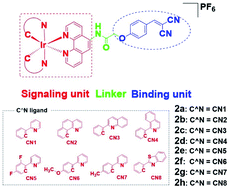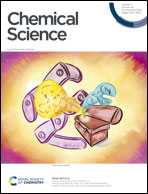Structure-guided discovery of a luminescent theranostic toolkit for living cancer cells and the imaging behavior effect†
Abstract
Dual-functional theranostics are powerful tools that can allow for the in-field understanding of cancer pathology, yet their use is held back by the paucity of suitable theranostics for living systems. Moreover, typical in vitro screening conditions for probe molecules do not necessarily generate candidates that can function effectively in the natural in cellulo environment, limiting their follow-up use in living systems. We introduce herein a general strategy for the development of an iridium(III) theranostic by grafting a well-known inhibitor as a “binding unit” onto an iridium(III) complex precursor as a “signaling unit”. To further optimize their emissive properties, we explored the effect of imaging behavior by incorporating different substituents onto the parental “signaling unit”. This design concept was validated by a series of tailored iridium(III) theranostics 2a–2h for the visualization and inhibition of EGFR in living cancer cells. By comprehensively assessing the theranostic potency of 2a–2h in both in vitro and in cellulo contexts, probe 2f containing electron-donating methoxy groups on the “signaling unit” was discovered to be the most promising candidate theranostic with desirable photophysical/chemical properties. Probe 2f selectively bound to EGFR in vitro and in cellulo, enabling it to selectively discriminate living EGFR-overexpressing cancer cells from normal cells that express low levels of EGFR with an “always-on” luminescence signal output. In particular, its long-lived lifetime enabled its luminescence signal to be readily distinguished from the interfering fluorescence of organic dyes by using time-resolved techniques. Complex 2f simultaneously visualized and inhibited EGFR in a dose-dependent manner, leading to a reduction in the phosphorylation of downstream proteins ERK and MEK, and inhibition of the activity of downstream transcription factor AP1. Notably, complex 2f is comparable to the parental EGFR inhibitor 1b, in terms of both inhibitory activity against EGFR and cytotoxicity against EGFR-overexpressing cancer cells. This tailored dual-functional iridium(III) theranostic toolkit provides an alternative strategy for the personalized diagnosis and treatment of cancers.



 Please wait while we load your content...
Please wait while we load your content...